Sopwith Camel
| Sopwith Camel | |
|---|---|
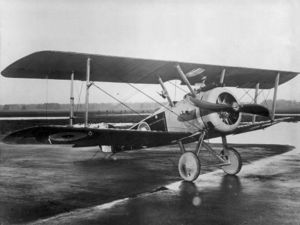 |
|
| Role | Biplane fighter |
| Manufacturer | Sopwith Aviation Company |
| First flight | 22 December 1916 |
| Introduction | June 1917 |
| Primary users | RFC (RAF) RNAS, AAF |
| Number built | 5,490 |
The Sopwith Camel was a British World War I single-seat biplane fighter introduced on the Western Front in 1917. It had a combination of a short-coupled fuselage, heavy, powerful rotary engine and concentrated fire from twin synchronized machine guns. The Camel was credited with shooting down 1,294 enemy aircraft, more than any other Allied fighter in the First World War.
Contents |
Design and development
Intended as a replacement for the Sopwith Pup,[1] the Camel prototype first flew on 22 December 1916, powered by a 110 hp Clerget 9Z. Known as the "Big Pup" early on in its development, the biplane design was evolutionary more than revolutionary, featuring a box-like fuselage structure, an aluminium engine cowling, plywood-covered panels around the cockpit, and fabric-covered fuselage, wings and tail. Two .303 in (7.7 mm) Vickers machine guns were mounted directly in front of the cockpit, firing forward through the propeller disc with synchronisation gear. A metal fairing over the gun breeches created a "hump" that led to the name Camel.[1] The bottom wing had dihedral but not the top, so that the gap between the wings was less at the tips than at the roots. Approximately 5,490 units were ultimately produced.[2]
Unlike the preceding Pup and Triplane, the Camel was not considered pleasant to fly. The Camel owed both its extreme manoeuvrability and its difficult handling characteristics to the placement of the engine, pilot, guns and fuel tank (some 90% of the weight of the craft) within the front seven feet of the aircraft, coupled with the strong gyroscopic effect of the rotary engine. The Camel soon gained an unfortunate reputation with student pilots. The Clerget engine was particularly sensitive to fuel mixture control, and incorrect settings often caused the engine to choke and cut out during takeoff. Many crashed due to mishandling on takeoff when a full fuel tank affected the center of gravity. In level flight, the Camel was markedly tail-heavy. Unlike the Sopwith Triplane, the Camel lacked a variable incidence tailplane, so that the pilot had to apply constant forward pressure on the control stick to maintain a level attitude at low altitude. However the machine could also be rigged in such a way that at higher altitudes it could be flown "hands off." A stall immediately resulted in a spin and the Camel was particularly noted for its vicious spinning characteristics.
Operational history
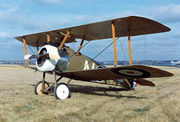
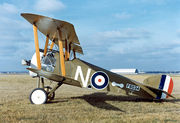
The type entered squadron service in June 1917 with No. 4 Squadron of the Royal Naval Air Service, near Dunkirk. The following month, it became operational with No. 70 Squadron of the Royal Flying Corps. By February 1918, 13 squadrons were fully equipped with the Camel.
The Camel proved to be a superlative fighter, and offered heavier armament and better performance than the Pup and Triplane. In the hands of an experienced pilot, its manoeuvrability was unmatched by any contemporary type. Its controls were light and sensitive. The Camel turned rather slowly to the left, which resulted in a nose up attitude due to the torque of the rotary engine. But the engine torque also resulted in the ability to turn to the right in half the time of other fighters,[3] although that resulted in more of a tendency towards a nose down attitude from the turn. Because of the faster turning capability to the right, to change heading 90° to the left, many pilots preferred to do it by turning 270° to the right. Agility in combat made the Camel one of the best-remembered Allied aircraft of the First World War. It was said to offer a choice between a "wooden cross, red cross and Victoria Cross." Together with the S.E.5a, the Camel helped to wrest aerial superiority away from the German Albatros fighters.
Major William Barker's Sopwith Camel (serial no. B6313, the aircraft in which the majority of his victories were scored,[4]) became the most successful fighter aircraft in the history of the RAF, shooting down 46 aircraft and balloons from September 1917 to September 1918 in 404 operational hours flying. It was dismantled in October 1918. Barker kept the clock as a memento, but was asked to return it the following day.
By mid-1918 the Camel was becoming limited by its slow speed and comparatively poor performance at altitudes over 12,000 ft (3,650 m). However, it was then used as a ground-attack and infantry support aircraft. During the German offensive of March 1918, flights of Camels harassed the advancing German Army, inflicting high losses (and suffering high losses in turn) through the dropping of 25 lb (11 kg) Cooper bombs and ultra-low-level strafing. The protracted development of the Camel's replacement, the Sopwith Snipe, meant that the Camel remained in service until the Armistice.
In summer 1918 a 2F.1 Camel (N6814) was used in trials as a parasite fighter under Airship R23
Variants
The Camel was powered by a variety of rotary engines during the production period.
- 130 hp Clerget 9B Rotary (standard powerplant)
- 140 hp Clerget 9Bf Rotary
- 110 hp Le Rhone 9J Rotary
- 150 hp Bentley BR1 rotary (gave best performance - standard for R.N.A.S. machines)
- 100 hp Gnome Monosoupape 9B-2 Rotary
- 150 hp Gnome Monosoupape 9N Rotary
Engine variants
With rotary engines, the crankshaft remained fixed while the cylinders and attached propeller rotated around it. The result of this torque was a significant "pull" to the right. In the hands of an experienced pilot, this characteristic could be exploited to give exceptional manoeuvrability in a dogfight. A 3/4 turn to the right could be done in the same time as a 1/4 turn to the left.
The Gnome "mono" engines did not have throttles and were at full "throttle" while the ignition was on - they could be "throttled" with a selector switch which cut the ignition to some of the cylinders to reduce power for landing. The Clerget, Le Rhone and BR1 had throttles, although reducing power involved simultaneously adjusting the mixture and was not straightforward, so it became common during landing to "blip" the engine (turn the ignition off and on) using a control column-mounted ignition switch, the blip switch, to reduce power.
Sopwith Camel F.1
- Single-seat fighter aircraft.
- The main production version. Armed with twin synchronised Vickers guns.
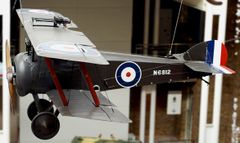
Sopwith Camel 2F.1
- Shipboard fighter aircraft.
- Slightly shorter wingspan
- One Vickers gun replaced by an overwing Lewis gun
- Bentley BR1 as standard engine
Sopwith Camel "Comic" Night fighter
Pilot seat moved to rear. The twin Vickers guns were replaced with two Lewis guns firing forward over the top wing on Foster mountings. Served with Home Defence Squadrons against German air raids. The "Comic" nickname was of course unofficial, and was shared with the night fighter version of the Sopwith 1½ Strutter.
F.1/1
- Version with tapered wings.
(Trench Fighter) T.F.1
- Experimental trench fighter.
- Downward angled machine guns
- Armour plating for protection
(See also Sopwith Salamander)
Operators
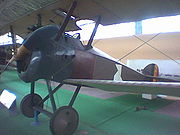
- Australian Flying Corps
- No. 4 Squadron AFC in France.
- No. 5 (Training) Squadron AFC in the United Kingdom.
- No. 6 (Training) Squadron AFC in the United Kingdom.
- No. 8 (Training) Squadron AFC in the United Kingdom.
- Belgian Air Force
- Canadian Aviation Corps
- Estonian Air Force
- Hellenic Air Force
- Latvian Air Force
- Royal Netherlands Air Force
- Polish Air Force operated 1 Camel post-war (1921)
- Swedish Air Force
|
|
|
- Royal Naval Air Service
- No. 1 Squadron RNAS
- No. 3 Squadron RNAS
- No. 4 Squadron RNAS
- No. 6 Squadron RNAS
- No. 8 Squadron RNAS
- No. 9 Squadron RNAS
- No. 10 Squadron RNAS
- No. 13 Squadron RNAS
Survivors

There are only seven authentic Sopwith Camels left in the world.
- One is in the Aerospace Education Center in Little Rock, Arkansas.
- One, restored to near-flying condition, is at the Brussels Air Museum Restoration Society (BAMRS) in Brussels, Belgium.
- A model F.1 (s/n B 7280) can be found at the Polish Aviation Museum. This Camel first flew in Royal Naval Air Service and then in the Royal Flying Corps. Two pilots who flew this aircraft shot down 11 German planes in total.
- N6812, a William & Beardmore built 2F1 Camel, was flown by Flight Sub Lieutenant Stuart Culley on 11 August 1918 when he shot down Zeppelin L 53, it is on display at the Imperial War Museum in London.[9]
- N8156 (RAF) is currently on display at the Canadian Aviation Museum. Manufactured in 1918 by Hooper and Company Ltd., Great Britain, it was purchased by the RCAF in 1924 and last flew in 1967. It is currently on static display.[10].
- A Boulton & Paul built F1 F6314 is on display at the Milestone of Flight exhibition at the Royal Air Force Museum, London.[11] Painted to represent an aircraft coded B of No. 65 Squadron RAF.[12]
Replicas
- A replica Sopwith F.1 Camel is on display at the National Museum of the United States Air Force in Dayton, Ohio. This aircraft was built by Air Force Museum personnel from original First World War factory drawings and was completed in 1974. It is painted and marked as the Camel flown by Lt. George A. Vaughn Jr. while flying with the 17th Aero Squadron.[13]
- A replica is currently under construction by the Northern Aeroplane Workshops for the Shuttleworth Collection[14], and another is under construction at the Great War Flying Museum.
- In 1969 Slingsby built a flyable Type T.57 Sopwith Camel Replica powered by a 145 hp Warner Scarab engine for use in a Biggles film. This aircraft is now on display at the Fleet Air Arm Museum, Yeovilton painted as B6401.[15][16]
- Old Rhinebeck Aerodrome flies a reproduction that was completed in 1992 with a Le Rhone rotary.
- A replica is on display at the Evergreen Aviation museum
Specifications (F.1 Camel)

Data from Quest for Performance[17]
General characteristics
- Crew: 1
- Length: 18 ft 9 in (5.71 m)
- Wingspan: 26 ft 11 in (8.53 m)
- Height: 8 ft 6 in (2.59 m)
- Wing area: 231 ft² (21.46 m²)
- Empty weight: 930 lb (420 kg)
- Loaded weight: 1,455 lb (660 kg)
- Powerplant: 1× Clerget 9B 9-cylinder Rotary engine, 130 hp (97 kW)
- Zero-lift drag coefficient: 0.0378
- Drag area: 8.73 ft² (0.81 m²)
- Aspect ratio: 4.11
Performance
- Maximum speed: 115 mph (185 km/h)
- Stall speed: 48 mph (77 km/h)
- Range: 300 mi ferry (485 km)
- Service ceiling: 21,000 ft (6,400 m)
- Rate of climb: 1,085 ft/min (5.5 m/s)
- Wing loading: 6.3 lb/ft² (30.8 kg/m²)
- Power/mass: 0.09 hp/lb (150 W/kg)
- Lift-to-drag ratio: 7.7
Armament
- Guns: 2× 0.303 in (7.7 mm) Vickers machine guns
Notable appearances in media

The Camel appears in literature and popular media as:
- One of the aircraft flown by Canadian pilot Arthur Roy Brown in the 2008 movie The Red Baron.
- The single-seater scout flown by the Royal Flying Corps Squadron in the semi-autobiographical, First World War air combat book Winged Victory written by Victor Maslin Yeates.
- The fighter flown by Biggles in the novels by W.E. Johns during the character's spell in 266 Squadron during the First World War. He also wrote a book, The Camels Are Coming.
- The "plane" of Snoopy in the Peanuts comic strip, when he imagines himself as a First World War flying ace and the nemesis of the Red Baron.
- The cover painting for musician Joe Walsh's 1973 album The Smoker You Drink, the Player You Get.
- The type of aircraft flown in the First World War by John and Bayard Sartoris in William Faulkner's Flags in the Dust.[18]
See also
- Clayton & Shuttleworth
Comparable aircraft
- Albatros D.V
- Fokker D.VII
- Fokker Dr.I
- S.E.5
- SPAD S.XIII
Related lists
- List of aircraft of the Royal Air Force
References
- Notes
- ↑ 1.0 1.1 Bruce 22 April 1955, p.527.
- ↑ Bruce 1955, p. 563.
- ↑ Clark 1973, p. 134.
- ↑ Ralph, Wayne. Barker VC: The Classic Story of a Legendary First World War Hero. London: Grub Street, 1999. ISBN 1-902304-31-4.
- ↑ 9 Bomb Squardon (ACC) entry at the Air Force Historical Research Agency website
- ↑ 17 Weapons Squardon (ACC) entry at the Air Force Historical Research Agency website
- ↑ 27 Fighters Squardon (ACC) entry at the Air Force Historical Research Agency website
- ↑ 37 Bomb Squardon (ACC) entry at the Air Force Historical Research Agency website
- ↑ Ellis 2008, page 148
- ↑ Sopwith 2F.1 Camel — Canada Aviation Museum
- ↑ Ellis 2008, page 145
- ↑ "Individual History Sopwith F.1 Camel F6314/9206M=". Royal Air Force Museum. 2007. http://www.rafmuseum.org.uk/london/collections/aircraft/aircraft_histories/74-A-18%20Camel%20F6314.pdf. Retrieved 2009-09-27.
- ↑ United States Air Force Museum 1975, p. 12.
- ↑ Shuttleworth Collection
- ↑ Jackson 1988, p. 349.
- ↑ "Sopwith Camel (replica) ('B6401')" Fleet Air Arm Museum. Retrieved 14 November 2008.
- ↑ Loftin, LK, Jr. Quest for Performance: The Evolution of Modern Aircraft. NASA SP-468. Retrieved: 22 April 2006.
- ↑ Quote: "Under fire from a pupil of Richthofen (the Red Baron), John's Camel caught fire over occupied France. Bayard's last sight of his twin brother was of John jumping out of his fighter feet first. Faulkner also wrote about the Camel (and Sartoris) in his famous story All the Dead Pilots."
- Bibliography
- Bruce, J.M. "Sopwith Camel: Historic Military Aircraft No 10: Part I." Flight, 22 April 1955, pp. 527–532.
- Bruce, J.M. "Sopwith Camel: Historic Military Aircraft No 10: Part II." Flight, 29 April 1955. pp. 560–563.
- Clark, Alan. Aces High: The War In The Air Over The Western Front 1914 - 1918. New York: G. P. Putnam's Sons, 1973. ISBN 0-29799-464-6.
- Ellis, Ken. Wrecks & Relics, 21st edition. Manchester: Crecy Publishing, 2008. ISBN 9 780859 791342
- Jackson, A.J. British Civil Aircraft 1919-1972: Volume III. London: Putnam, 1988. ISBN 0-85177-818-6.
- Robertson, Bruce. Sopwith: The Man and His Aircraft. London: Harleyford, 1970. ISBN 0-90043-515-1.
- Sturtivant, Ray and Gordon Page. The Camel File. Tunbridge Wells, Kent, UK: Air-Britain (Historians) Ltd., 1993. ISBN 0-85130-212-2.
- United States Air Force Museum Guidebook. Wright-Patterson AFB, Ohio: Air Force Museum Foundation, , 1975.
- Winchester, Jim, ed. "Sopwith Camel." Biplanes, Triplanes and Seaplanes (Aviation Factfile). London: Grange Books plc, 2004. ISBN 1-84013-641-3.
External links
- Sopwith Camel
- Sopwith Camel images at Airliners.net
- Camel photos and links to museums with Camels
- Canadian Aviation Museum Camel
|
||||||||
|
|||||||||||
|
||||||||||||||